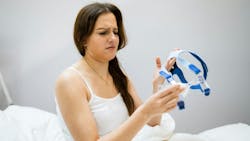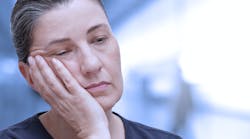A modern-day sleep apnea resolution for dental professionals to recommend
Sleep apnea affects nearly 10% of Americans each year.1 Sleep apnea is classified as either obstructive or central.1 Obstructive sleep apnea (OSA) is caused by the tongue blocking off the airway. Central sleep apnea (CSA) is more complex because it involves the brain intuitively stopping a person from breathing while they sleep.1
Dental professionals are treating sleep apnea more often because they recognize how the tongue, coupled with a narrow arch form, can induce sleep-disordered breathing, which can ultimately turn into sleep apnea.2 Patients who gasp for air in their sleep often display other symptoms on their teeth and tissues. Until recently, patients diagnosed with sleep apnea were treated with various types of CPAP machines.1,2 Now, a new treatment has emerged: hypoglossal nerve stimulation.
Sleep apnea is typically treated with a CPAP (continuous positive airway pressure) machine that pushes oxygen into a patient’s body so the airway does not close off.3 Many patients struggle to adapt to a CPAP machine.4 They complain that it’s too uncomfortable and their quality of sleep is worse with a CPAP machine than it was when their sleep apnea was untreated.4 But if sleep apnea is not treated for too long, it can cause extreme daytime fatigue or several types of cardiac issues.4,5
What is this new treatment?
The new form of sleep apnea treatment is through stimulation of the hypoglossal nerve, called a hypoglossal nerve simulator, and is organized through a wire, a remote control, and a patient’s cellular phone. The hypoglossal nerve is the 12th cranial nerve that controls the tongue.6 The ability to swallow, speak, and freely move the tongue are all influenced by this nerve.6 It can be found on the lateral borders and ventral surfaces of the tongue,6 and it influences sleep apnea because OSA is caused when the tongue relaxes and blocks off a patient’s airway as they sleep.5,6
OSA patients who don’t have success with a CPAP machine may be ideal candidates for the implanted wire treatment. During surgery, the wire is placed inside the patient’s body with two small incisions: one near the hypoglossal nerve and the other near the collarbone region.1 Recovery time is relatively quick. After the surgery, the patient learns how to control their tongue by turning the wire on with the remote control to stimulate the hypoglossal nerve.1
While the patient is sleeping, the remote sends pulses to the wire to keep the tongue from becoming too relaxed and blocking the airway.1 A patient can review how much their sleep apnea has decreased with their cellular device.1 Patients and dental professionals who have questions about hypoglossal nerve simulator sleep apnea treatment can reach out to a sleep apnea doctor.
Patients who have a nerve-stimulated wire treatment should let all their medical professionals know about the surgery and wire. Dental professionals should document all changes in a patient’s current health history form. There is a concern that if the implanted wire is not properly turned off during dental treatment, certain dental equipment could cause a reaction due to the magnetics in the nerve stimulator and dental equipment.7 Patients should make sure their nerve stimulator device is powered off before their dental appointment.
What dental professionals can do to guide their patients
- Educate patients about sleep apnea. Good chairside education can enlighten patients about how sleep-disordered breathing and sleep apnea can cause damage to their teeth and oral tissues.
- Show patients how a narrow arch can limit their tongue space when they sleep.
- Encourage patients to discuss sleep concerns with a medical provider and remind them that a sleep study is needed to diagnose sleep apnea.
- Document any teeth and tissue pathology that could be related to sleep-disordered breathing or possible sleep apnea. A patient should recognize the benefits of relaying their sleep study or any sleep apnea consultations they have with their dental provider.
Recognize that due to a multitude of technologies, new treatments for various ailments are evolving and we need to stay up to date on our continuing education to make sure we’re always practicing safely with our patients.
References
1. Foutain L. What is inspire sleep apnea treatment and how does it work? Sleep Foundation. November 3, 2023. https://www.sleepfoundation.org/sleep-apnea/what-is-inspire-sleep-apnea-treatment
2. Gianoni-Capenakas S, Gomes A.C., Mayoral P, et al. Sleep-disordered breathing: the dentist’s role: a systemic review. JDSM. 2020;7(1). doi:10.15331/jdsm.7108
3. Berggren K, Broström A, Firestone A, et al. Oral health problems linked to obstructive sleep apnea are not always recognized within dental care—as described by dental professionals. Clin Experimental Dent Res. 2022;8(1):84-95. doi:10.1002/cre2.517
4. Pogach M. I can’t tolerate CPAP, what can I do? Harvard Health. July 29, 2020. www.health.harvard.edu/blog/i-cant-tolerate-cpap-what-can-i-do-2020072920672
5. Sleep apnea. Cleveland Clinic. 2024. https://www.my.clevelandclinic.org/health/diseases/8718-sleep-apnea
6. Hypoglossal nerve. Cleveland Clinic. 2023. www.my.clevelandclinic.org/health/body/21592-hypoglossal-nerve
7. Inspire system implant manual. 200-079-101 Rev A_5. 2014. Inspire Medical Systems. https://www.accessdata.fda.gov/cdrh_docs/pdf13/P130008d.pdf
Tracee S. Dahm, MS, BSDH, is an adjunct clinical instructor for the North Idaho College School of Dental Hygiene in Coeur d’Alene, Idaho. Tracee also works in private practice. Tracee has published in several dental journals, magazines, webinars, and textbooks. Her research interests include trends in dental hygiene and improving access to dental care for the underserved. She can be reached at [email protected].
About the Author

Tracee S. Dahm, MS, RDH
Tracee S. Dahm, MS, BSDH, is an adjunct clinical instructor for the North Idaho College School of Dental Hygiene. She also works in private practice. Dahm has been published in dental journals, magazines, webinars, and textbooks, and featured on dental podcasts. She is a key opinion leader on cutting-edge innovations in the hygiene field. Her research interests include trends in dental hygiene, improving access to dental care for the underserved, and mental health. She can be reached at [email protected].


